Action Comics #5 (DC, $3.99)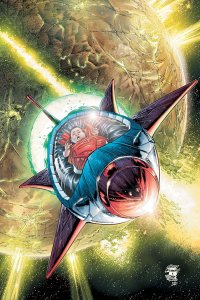
By Adam Prosser
Doomed Planet. Desperate Scientists. Last Hope. Kindly Couple.
This, the eight words on the first page of Grant Morrison’s All-Star Superman, combined with four economic panels, stand as a symbol for everything that’s screwed up about comics. Because as utterly iconic as that page has become among superhero fans, telling Superman’s origin as concisely as possible, and hitting the comics culture like a mission statement–OK, that’s out of the way, now let’s get to the good part; as much as that page represents all a superhero comics writer would ever need to say about Superman’s origin in the early years of the twenty-first century, largely because everyone already knows it—I don’t mean every comics nerd, I mean literally everyone in America and a large portion of the rest of the world’s population; as praised and revered as that single page has become, rightfully so, for being the apotheosis of efficient storytelling and a model for everyone who wants to write superhero comics–hardly anyone writing, editing, or publishing comics has bothered to learn from it.
Which is why it was so dispiriting to pick up Action Comics #5 and realize that Grant Morrison is now ignoring his own advice.
Because the fact is, if your goal is to win over new readers to your Superman book, retelling Superman’s origin yet again is not going to make a difference. They’ve heard that song before. If they’re not reading your comics, either they just flat-out didn’t like the tune, or they’re waiting impatiently for you to move past the first few bars and deliver a hooky chorus. Something with a nice beat, that you can dance to.
So let’s just say it: the New 52, Action Comics included, is not aimed at new readers. I have no doubt people at DC believe it is, and tragically, probably believe that it’s working thanks to the much-lauded sales bump of the past few months (you know, the one that’s already tapering off and shows absolutely no signs of being anything more than a fleeting outlier). But the fact of the matter is, hardcore superhero readers have now convinced themselves to enjoy reading dumbed-down, generic, repetitive versions of the same few iconic stories in the belief that this will help bring new readers and therefore justify their existence, or something. The result is a series of comics that nominally serves as a “gateway for new readers” due to their lack of continuity and pedantic hand-holding, but doesn’t actually tell a story that anyone would want to read. And yet superhero fans are OK with this, even though there can’t actually be anything fresh or interesting here for them, because they somehow believe that theoretical “new readers” are deriving pleasure from it, and somehow that’s enough. Even though comics like Justice League #1 offer precious little that’s compelling or intriguing to someone who isn’t already submerged in superhero comics either. A bad, lame, simplistic story is a bad, lame, simplistic story, and dumbing it down for the supposed masses isn’t going to change anything.
In other words, an awful lot of superhero fans, and the editorial staff at DC, seem to have decided it’s necessary to destroy superhero comics in order to save them.
Action Comics #5 is, at least, a well-executed comic. Superman’s origin IS still a good story, and retains its mythic power. Krypton, in artist Andy Kubert’s rendering, looks appropriately beautiful and alien. Kal-El’s folks (both biological and adopted) reveal themselves to be likeable and heroic, the escape from the doomed planet is exciting and dramatic, and the sentiment is earned throughout. Near the end something new seems to be happening, though we have no idea what it is and thus have little reason to care.
None of this changes the fact that this simply isn’t the comic we need right now, and worse, it’s actively part of the problem. It’s reinventing the wheel, when what we need is a cradle-shaped rocket to bear new ideas safely away from the imploding mess that is the mainstream superhero genre.
Rating: 




Out of a Possible 5 Stars
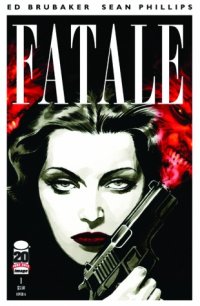 FATALE #1 (Image Comics, $3.50)
FATALE #1 (Image Comics, $3.50)
By Devon Sanders
24 hours later and as I type this, I find myself still trying to process how I feel about Fatale #1. I loved it but I know I won’t be coming back.
Well, at least not until it’s collected. Issue one is a gorgeous piece of set-up. A woman walks through the ages destroying the lives of every man who comes to know her. Gangsters and Nazis show and one man, with one look, realizes he’s a dead man. Writer Ed Brubaker’s premise is a great one, full of the promise of secrets revealed and artist Sean Phillips bringing his best to the panel. Every panel is a clinic in noir and the two put in FIVE STAR work.
But… the first issue reads very much as the first act of a movie and does nothing but further reinforce that the tandem of Brubaker/Phillips works best read in one sitting. Once again, I want to stress this is a FIVE STAR effort and for those wanting to experience this in the pure monthly form, you will be rewarded with a monthly stunner. This issue including a prose piece on H.P. Lovecraft by writer Jess Nevins with an illo by Phillips, making it all-winner. Me, it will kill me but I will have to wait however long for my reward.
I have ZERO doubt it will all be worth it.
Rating: 




Out of a Possible 5 Stars
Wolverine and the X-Men: Alpha and Omega #1 of 5 (Marvel, $3.99)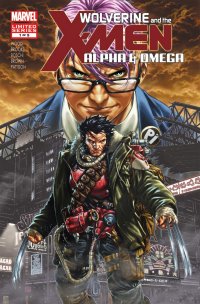
By Jeb D.
There are significant chronological gaps in my X-Men reading, so it was only recently that I learned that Brian Wood had actually worked on Generation X when he was starting out back in the early 2000’s. I had sort of assumed that his decision to focus on a showdown between Wolverine and Quentin “Kid Omega” Quire was a way of getting his feet wet, and avoiding the complications of all the multi-player romance and relationships that are both this franchise’s selling point and Achilles heel. Turns out that Wood simply has a fun idea for a story to tell, and with alternating art from Roland Boschi with Dan Brown, and Mark Brooks with a small army of inkers, he gets this miniseries off to an entertaining start.
As anyone who’s encountered the character before will know, Quire’s not the ideal candidate to go “Back to School,” no matter whether his recent actions suggest that he’s tempered some of his more negative traits. But even the most well-meaning diabolical genius can get bored having to slog along at the pace of those he considers his inferiors… in particular, he’s no great fan of Wolverine’s “brawn over brains” approach, and decides to give his “headmaster” a challenge that his mutant abilities never prepared him for: after mentally knocking out Logan and sparring partner Armor, he sends them off into a psychically-created world where the two are involved in deadly espionage, and where they’re completely unaware of not only what they’re doing, but of the fact that they even have mutant abilities in the first place. The virtual environment in which Wolverine and Armor find themselves is a familiar convention, well-executed by Brooks. Interestingly, the “reality” sequences by Broschi are actually a tad more cartoony, and while they do a good job of capturing the adolescent brattiness that co-exists with Quire’s formidable powers, there’s a decided drop in the tension level each time we return from Wolverine’s pshychically-imposed adventures to the environs of the Jean Grey Institute.
I have my doubts that this story is headed anywhere particularly startling (among other things, it’s a self-contained miniseries), and Logan’s virtual-world “assignment” feels pretty old-hat, but I like the sharpness, both in tone and appearance, of Wood’s version of Quire. And while (with apologies to Jason Aaron), I really don’t much care what anyone does with Wolverine anymore, he’s well-handled here; less tiresome and overbearing than he can be. Definitely worth a look-in for Wood fans curious about his new project.
Rating: 




Out of a Possible 5 Stars
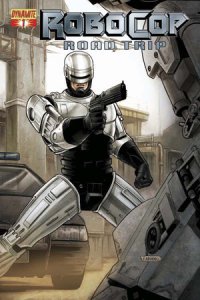 Robocop: Road Trip #1 (Dynamite Entertainment, $3.99)
Robocop: Road Trip #1 (Dynamite Entertainment, $3.99)
By Bart Bishop
I grew up loving Robocop. That’s probably not a great thing, considering Paul Verhoeven’s entry into the franchise is probably one of the most violent movies I’ve ever seen! There was a timelessness to that first movie, dealing with themes of corporate greed, consumerism, the media, and the soul. Although it was a product of 1987, it feels even more relevant today. Couple that with incredible performances, special effects that hold up, iconic imagery and incredible quotes, and you’ve got a classic. Unfortunately, the sequels came along. I probably have fonder memories of the Frank Miller penned Robocop 2 than it deserves, but I know the third movie is a blight upon civilization. How a trilogy of films that never quite took the world by storm spawned two animated series, a live-action tv show, and three made-for-tv movies I’ll never know. What’s hilarious about all the spin-offs, including Dynamite’s new comic book Robocop: Road Trip is that they ignore the events of the latter two movies.
“Following the events of the first Robocop film”, according to the recap page, America is embroiled in revolution. The evil corporation OCP has finally gotten ahold of Old Detroit, so Robocop and his fellow former policemen are trying to get out of Michigan to find help. It’s a pretty simple premise, but throw in the fact that “The Old Man”, the head of OCP from the movies is on his deathbed and wants Robocop’s body for his own, and you’ve got a nice bit of conflict. Add to that the fact that Lewis, Robocop’s partner, has been murdered and Robo is losing his mind as a result, and there’s a recipe for solid drama.
Unfortunately, writer Rob Williams tries to recapture the irreverant tone of the first movie and can’t quite pulll it off. All the ingredients are there: guns, blood, harsh language, a stab at social satire and the question of “What is a man?” It doesn’t, however, all gel together. Admittedly I am unfamiliar with Williams’ work, which includes 2000 AD, Cla$$war, and odd jobs at Dark Horse and Marvel, and the man should be given credit for having a go at a character that is apparently hard to get a handle on. Only Frank Miller in his prime, and maybe Garth Ennis, could understand the combination of perversity and nobility that screenwriter Ed Neumeier and director Verhoeven brought to the titular character and the world he inhabits. A couple of years ago Darren Aronofsky was attached to a remake, but it got stuck in development hell which is a real shame because that director would have something fresh to say with this material.
As is, Williams is too indebted to the past. There’s a promising opening page with a young Alex Murphy out fishing with his dad, although it’s unsettled with an outburst from young Alex that lacks a clear tone or context, and little ramifications. Does Robocop in the present (our future) feel guilty over berating his father for forcing him on the boring fishing trip? Did he learn a lesson, and thus miss his father? It’s unclear, and this may be foreshadowing for a later issue, but it’s an odd moment. There’s then an abrupt transition into Robo attempting to arrest thugs, but it’s vague and confusing. Lip service is given to American being chaotic, but four thugs do not make a riot and the streets of Detroit appear otherwise empty.
The introduction of the golden Robocop, controlled by “The Old Man” makes for funny dialogue and a nice action beat, although there’s a missed opportunity for Robo to wonder if he’s hallucinating during all this. See, the entire issue he’s followed by the “ghosts” of Lewis, Clarrence Bodicker, Dick Jones and others, and admittedly Williams synchs their voices up with the movies. Still, the whole first half feels clunky as all this is introduced with little hurrah, and it doesn’t all start to come together until the Media B.R.E.A.K. and corporate machinations at the halfway point. Nice winks to fans like rampaging E.D.-209s can be fun, but this is all, inevitably, familiar. Robocop has existed across multiple mediums for twenty five years now, and although there’s that previous aforementioned timelessness there should also be attempts to update the character to the 21st century. One brief mention of the Internet is not enough.
What about the art? It’s competent enough, but there’s something off about the physicality of Unai de Zarate’s human form. Characters resemble men and women, but appear swollen and sponge-like. There’s also very little in the way of backgrounds, employing the Rob Liefeld method of empty space. This is the future, and more than that the future of a real life city. Work should’ve been done to incorporate the familiar streets and landmarks of Detroit with subtle and not so subtle changes. This “Old Detroit”, however, could be any generic metropolitan area, which is unfortunate because the city is like an individual character that informs the mood of the movie. Speaking of mood, thick black inking makes for a murky palette, and entire panels are depicted with single shades of greens and oranges. This may have been employed to establish mood and atmosphere, but instead feels lazy and limiting. The cover by Fabiano Neves, meanwhile, is a simple but striking image of Robo facing off with an E.D.-209, with detailed and clean lining I wish the inside pages possessed.
Still, the characters very clearly look and sound like the actors from the movies. It all feels perfunctory at this point, however, as little insight has been provided into Robocop, the supporting characters, or the future that encompasses them. Having not read Dynamite’s first Robocop release, 2010’s “Revolution”, I can’t say if that series capitalized on the potential for a post-apocalyptic landscape, a Robocop meets Mad Max, but the start of this new series sure hasn’t. The same path the movies went down, of mirroring Robo with a bigger, better version of himself permeates this premise. Why can’t he fight something else besides robots, especially robots described as being the “new model”?
Worth it for those nostalgiac for the movies, but I’m hoping the next incarnation of Robocop tries for a completely different take.
Rating: 




Out of a Possible 5 Stars
Fearless, Vol. 1 (Image, $14.99)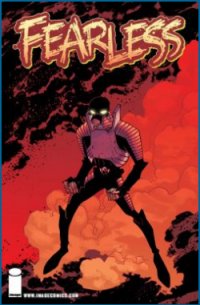
By D.S. Randlett
If there’s one thing that superhero comics are about, and will always be about, it is the transformation. Whether it is the pulling off of a pair of glasses or the pulling on of a mask, superheroes have been all about unleashing parts of the Self that the polite society external to the hero just can’t handle. But of course, little does the society around the hero suspect just how much it needs the secrets that save them every day to remain secret. The hero, in turn, keeps his head down. It’s easy to see how the idea of the addict superhero could arise naturally from this theme. Addicts are the keepers of sordid secrets, and for some, their drugs of choice help them unleash parts of themselves that they otherwise might not be able to. For some, drugs offer the same sense of liberation that the superhero fantasy does. Hourman from the Justice Society is probably the most visible manifestation of this species of superhero. The problem with the addict superhero is that, beyond the initial similarities between the emotional contexts of addicts and superheroes, the nature of ongoing storytelling doesn’t really lend these same superheroes the ability to reflect the actual lives of addicts. Hourman struggles with his addiction sometimes to gin up some pretty cheap drama, but most of the time he’s the master of his Miraclo habit. Lesser men would be junkies for the stuff. Fearless manages to flip that script a bit, and to some success.
The story follows a superhero who goes by the name of Fear. He sports a gas mask and a powered up armored suit. The mask, as always, is the most important bit. In his secret identity, Fear is a man who is himself paralyzed with fear and anxiety. There are flashbacks of him embarrassing himself at a birthday party, or humiliating his wealthy father in front of other people. The boy who will become Fear is sent to a tutor who has some experience with a similar anxiety disorder. This tutor, named Lionel, ends up becoming Fear’s Alfred, who introduces him to an experimental drug which allows its users to feel absolutely no fear. At all.
Throughout most of the book, Fearless explores the main character’s father issues, which are at the source of his anxiety problem. This holds the book back a bit, as the way the plot brings these issues to light makes it feel like we’re seeing the climax to a story that we’ve missed out on. There are revelations that must mean a lot to the characters, and the beats that bring these revelations get that across, but they mean pretty much nothing to the reader. These are moments that could have really registered, for they are not dumb, and they are brought to life with some skill by artist P.J. Holden, but they lack the proper context to be really effective.
The final section of the book (presumably the fourth issue) really brings out what is interesting about its characters. It doesn’t so much redeem to book’s earlier mistakes as it does manage to explore its core themes more effectively. What’s interesting is that, at the end, is that Fear is put in the position of being cut off from the drug that he’s absolutely dependent on. To say where the story goes from there would be to spoil some of the book’s greatest pleasures, so I will refrain. I will say that towards the end, Fearless gets over its own crutches and begins to explore its main character in some truly compelling ways. Just when you think it is going to embrace some of the addict superhero’s more worn cliches, it turns them on its head. Thankfully, the creators seem interested in doing more with this character, as the book ends just where it seems that they’ve finally discovered just who Fear is and what kind of stories he can tell.
Fearless certainly isn’t lacking for ambition. It has a clear vision of who its characters are and where it wants to take them, but unfortunately the most interesting destinations seem to lie just over the horizon of this volume’s ending. If Fearless ever gets a sequel or becomes an ongoing, I’ll be right there in line for it.
Rating: 




Out of a Possible 5 Stars
 Avengers Annual #1 (Marvel, $4.99
Avengers Annual #1 (Marvel, $4.99
By Jeb D.
“NOTE: THIS STORY TAKES PLACE BEFORE FEAR ITSELF #1.”
Hmmm, OK… so I guess we can just skip it, right?
It’s honestly tempting to toss that off as a review, and this comic teeters right on the edge of that being the appropriate response. Doesn’t quite fall over, though.
Picking up from where the New Avengers Annual left off, Steve Rogers, Tony Stark and company square off with Simon Williams and his crew of D-list “Revengers,” and much mayhem ensues. Said mayhem is rendered by Gabriel Del’Otto in his usually gorgeous style; with the help of colorist Ive Svorcina, this book is filled with action scenes as dynamic as any the artist has brought us. This being a Brian Bendis comic, there are also extended dialog sequences, and Del’Otto’s attention to tense body posture and facial detail at times threatens to make even a Bendis word balloon superfluous.
But while there are those of us that will, from time to time, pick up a book solely on the basis of the art, most of the time we’re looking for the total story to repay our five bucks. And for fans of Wonder Man, the first 2/3 of this comic look to be revisiting their complaints from the first installment: that, as written, Simon bears virtually no resemblance to most of his previous incarnations (including Bendis’ own). He’s “angry,” but in a snarling, pompous supervillainy kind of way, and while one can see his point, he doesn’t really develop it, and never much sounds like himself as he expounds…
[If you’re at all spoiler-phobic (or in any way likely to read this comic), STOP RIGHT HERE!]
…until near the end.
And I’m sorry, I know there’s no way I can make this completely spoiler-free… all I can say is that, for me, the sneaky payoff that Bendis has up his sleeve works—not so much because it’s convincing in and of itself (I’m actually not sure it is); more that it promises interesting developments to come. And what really sucks is that I’ve just blown the principal fun to be had with this comic: the little frisson of “Aha!” that comes with a good comic-booky revelation. Once you know that there is one coming, even if you don’t know the specifics, a lot of the entertainment value of this book leaks out; you might as well just read the recap pages in the upcoming issues of the individual titles.
But, hey… damn fine artwork.
Rating: 




Out of a Possible 5 Stars